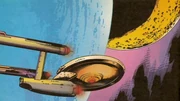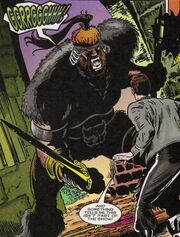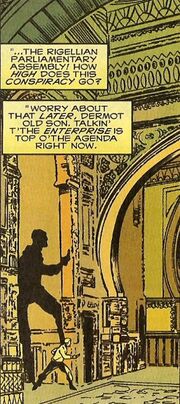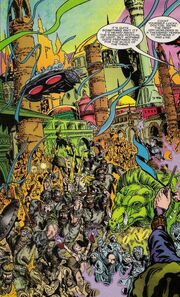- For the mirror universe counterpart, see Rigel VII (mirror).
Rigel VII, or Aulia, was the seventh planet in orbit of the Rigel system in the space of the galaxy's Alpha Quadrant. It was a class M planet and had an enormous moon called Golia. It was the homeworld of the Rigellians and the Kaylar. (FASA RPG module: The Orions: Book of Common Knowledge)
- Star Trek Maps and The Worlds of the Federation make Rigel VI and Rigel VII a double planet system, in a trojan orbit. It is unclear if this means that they are double planet system orbiting a common center (making Rigel VI the massive "moon" seen around Rigel VII), or if they simply share the same orbital distance, with one in a Trojan orbit of the other.
Environment[]
It was quite a large world (ST references: Star Trek Maps, The Worlds of the Federation), but Aulia had an Earth-like gravity of 1.0 g and a 27-hour day. It was a class M planet with a terrestrial atmosphere, and a cool temperate climate (FASA RPG module: The Orions: Book of Common Knowledge). It had a year that lasted 24.41 Earth years and an average temperature of 5°C. (ST reference: Spaceflight Chronology)
- The SFC states that Rigel V has a diameter of 32,150 km, much more than the FASA RPG's 12,580 km, and that it lies 20.1 × 10^8 km, ~13.4 AU, from the star, though this is greatly at odds with the few hundred AU implied by the Decipher RPG module: Worlds, below.
The most striking feature of Rigel VII was its huge moon, Golia. Subtending 30 degrees, it could nearly fill the whole sky, and could not be covered by two hands at arm's length. Its rugged, cratered and fissured surface was easily visible at most times of the day or night; the bright-side lit up the landscape at night, and even half-full the blue-lit dark side was visible. Eclipses of Golia were frequent and sometimes quite lengthy—a full half-day might be cast in twilight, or the moon might be completely hidden all night—while solar eclipses were not uncommon either.
The spectacle of the ballet of the moon, sun and planet was said to be soul-stirring and awe-inspiring, not easily forgotten. (FASA RPG module: The Orions: Book of Common Knowledge)
This world was the inspiration of the song Moon Over Rigel VII. (TOS movie: Star Trek V: The Final Frontier)
However, Golia's great size raised huge tidal forces, where the difference between low tide and high tide was at least 150 meters and often greater. The orbits of the planet and moon also made the tides highly chaotic, with high tides sometimes occurring less than two hours apart, or low tides lasting a day or more. Due to the irregular coastlines and shapes of the oceans, the shorelines suffered huge deluges at least twice a day. These tidal bores surged up narrow straits as 50-meter-high walls of water at high speeds, and were quite destructive.
The rest of Aulia was a world of natural beauty and nearly untouched wilderness. The vegetation was lush and plentiful, and provided significant quantities of food and medicinal compounds. However, harvesting it was difficult and expensive due to the tides.
It had a total surface area of 497,177,120 square kilometers and, with 29% land mass, a total land area of 144,181,360 square kilometers. About 42% of its makeup was normal metals, with 14% radioactive elements, 11% gemstones, 7% industrial crystals, and trace amounts of special minerals. (FASA RPG module: The Orions: Book of Common Knowledge)
History[]
Around 998,000 BCE (reference stardate −10,000/00), the Masters seeded Rigel VII with life, new and promising forms intended to evolve over a million years or so into an intelligent species capable of space-flight and revering the long-dead Masters as gods. (FASA RPG module: The Orions: Book of Deep Knowledge)
- These species may have become the humanoid Rigellians and Kaylar.
The Orions attempted to colonize Rigel VII on at least four separate occasions, and left behind the ruins of their castles and fortresses, mines, logging camps, fishing towers, spaceports, plantations and villages. Each effort was thwarted either by the tides or by Kaylar attacks. Every time the Orions cut their losses and departed, and had no interest in trying again by the late 23rd century. (FASA RPG module: The Orions: Book of Common Knowledge)

The USS Enterprise over Rigel VII
In 2254, Rigel VII was visited by the USS Enterprise on the eve of its entry into the Federation. Rogue elements of the Rigellian population took the opportunity to rebel against joining the Federation and launched a coup, with the Rigellian warrior caste, the Kaylar, attacking Federation personnel. Seven crew members were injured, including Spock, Nano and Sita Mohindas, and three were killed, including Yeoman Dermot Leon Cusack. The incident led to Rigel's admission into the Federation being rejected. (EV comic: "Our Dearest Blood")
- Star Charts states that the Enterprise made first contact with Rigel VII in 2254.

A Kaylar warrior
However, the incident did shock much of Rigellian society, spurring them to continue their reformations and to remove the more barbaric elements of their society. It was thought that Rigel VII could quite possibly claim its place in the Federation. (EV comic: "Nor Iron Bars a Cage")
The attacks on Rigel also had a profound impact on Captain Christopher Pike. The memory of the incident was used shortly after by the Talosians when they held the captain in captivity. (TOS episode: "The Cage")
By the mid-2260s, the Rigellians of Rigel VII had been admitted to the Federation. (EV comic: "Our Dearest Blood")

The interior of the Rigellian Parliamentary Assembly
In the late 23rd century, Humans began to re-occupy some of larger and stronger fortresses and castles and attempted to renovate them as expensive, exclusive resorts, supplying tours by air of the ruins and excursions to the sea. Three corporations requested permission from Rigel Space Control to construct proper spaceport facilities. (FASA RPG module: The Orions: Book of Common Knowledge)
- The outcome of these settlement plans is unknown.
In reference stardate 2/1203 (circa 2270), Orion blood fever was discovered when it first broke out among the population of Rigel VII. The disease spread to ravage Klingon settlements near the Triangle region of space before quarantines came into effect. (FASA RPG modules: A Matter of Priorities, Star Trek IV Sourcebook Update)
Backed by the Federation, a global computer network was later built to provide education and outside perspectives for the citizens of Rigel VII. This crashed catastrophically in 2362 when the Kobliad criminal Rao Vantika used a subspace shunt to access and purge everything in its active memory. The resulting economic collapse wiped out almost all the progressive pro-Federation businesses on the planet. (DS9 episode: "The Passenger", Decipher RPG module: Worlds)
By 2365, Rigel VII was a Federation member, and it ambassador to the UFP was Daniel Cheney. (ST reference: The Worlds of the Federation)
- This seemingly contradicts the depiction in The Worlds of the Federation of a primitive world populated by Kalar (the spelling used there) and avoided by other races. This primitive version may represent an older, pre-Federation Rigel VII.
Throughout the early 2370s, viewscreens in the Promenade and Replimat of Deep Space 9 showed advertising for Rigel VII and other worlds, promising the "spectacular castles of Rigel VII". (DS9 episodes: "Whispers", "What You Leave Behind")
- This information was visible on background computer displays in several episodes of Star Trek: Deep Space Nine.
Politics[]
The seat of Rigellian government was the Rigellian Parliamentary Assembly. (EV comic: "Our Dearest Blood")
Rigel VII was under a quarantine and non-aligned prior to development of a warp drive. (ST reference: Star Charts)
The Rigellians of Rigel VII were Federation members by the mid-2260s. (EV comic: "Our Dearest Blood")
- Star Charts states that Rigel VII is non-aligned, non–warp capable, and under a quarantine (likely due to the Prime Directive). This is assumed to be prior to Federation membership.
Culture[]

The dominant species on Rigel VII were the humanoid Rigellians (EV comic: "Our Dearest Blood") and the Kalar. They had a population of 10,000 circa 2270 (ST reference: Star Trek Maps) which rose to some 725,000 by the mid-2360s. (ST reference: Star Charts)
- Many sources have Kalar/Kaylar as the sole native inhabitants of Rigel VII, while "Our Dearest Blood" introduces the more human-like Rigellians, with the Kalar as their subrace. It is possible that the name Kalar/Kaylar can apply to cover both populations and the higher population figures include both.
The native Kalar were spread across Rigel VII. They were known to be quite aggressive, and early efforts at communication resulted in conflict. They were quite primitive technologically, and rated only a D-plus on the Richter Scale of Culture. The Kalar preferred their solitude, and space travelers generally avoided Rigel VII completely. (ST reference: The Worlds of the Federation)
The Rigellian Festival of Light was an important festival on Rigel, though outsiders were rarely permitted to see it. It featured parades by Kaylar warriors and native Rigellian animals, with bursts of light like fireworks. (EV comic: "Our Dearest Blood")
Economics[]
Aulia had a technological/sociopolitical index of 111220-13 and a planetary trade profile of BDEEDFF/B(E). (FASA RPG module: The Orions: Book of Common Knowledge)
By the mid-24th century, herbs from this world were used to make a type of scented shampoo. Darryl Adin preferred it. (TNG novel: Survivors)
Places of interest[]
Rigel VII had no known capital city. (ST reference: Star Charts)
| This article or section is incomplete |
|---|
| This article is marked as lacking essential detail, and needs attention. Information regarding expansion requirements may be found on the article's talk page. Feel free to edit this page to assist with this expansion. |
Last Unicorn & Decipher version[]
- Star Charts and The Worlds of the Federation both claim that Rigel VII is a pre-industrial world, and that the Kaylar are the dominant, but primitive species. The Last Unicorn and Decipher RPGs present a different version of Rigel VII, where it is the Orion homeworld. (The ST references: Star Trek Maps, The Worlds of the Federation) and the FASA RPG module: The Orions: Book of Common Knowledge instead choose Rigel VIII.) Since canon and other appearances of Rigel VII depict it as a Kaylar world, this article assumes that to be primary, and the LUG/Decipher version is assumed to be secondary.
Rigel VII, called Kolar, was the seventh planet in the Rigel system. It was a class M planet and had an enormous moon called Haladar, a class F planet in its own right. It was the likely homeworld of the Orions and the reputed headquarters of the Orion Syndicate; as such it was often called simply Orion. (Last Unicorn RPG modules: Star Trek: The Original Series Core Game Book, Star Trek: The Next Generation Core Game Book; Decipher RPG modules: Aliens, Worlds)
Culture[]
By the late 24th century, Rigel VII was inhabited by 2 billion Orions, 800 million Kaylar, and 100 million members of miscellaneous other species. (Decipher RPG modules: Aliens, Worlds)
Rigel VII was known as a decadent, barbaric world, described as dusty, spicy and exotic. It was home to Orion kingdoms and tribes of Kaylar, known for war, romance and conspiracy. There were interesting ancient ruins and concealed shipyards for smuggling and piracy. (Decipher RPG modules: Aliens, Worlds) There was also a profitable tourist trade. (Last Unicorn RPG module: Star Trek: The Next Generation Core Game Book)
Wars between the Orion Emperor and his seceding vazaks were fought with Kaylar slave soldiers, who used laser cannons dragged by tandu-beasts to besiege diburnite fortresses. (Decipher RPG module: Worlds)
Rigel VII was also the reputed home of the Orion Syndicate, though if so, it wisely kept its main operations far away in the Alpha Quadrant. (Last Unicorn RPG module: Star Trek: The Next Generation Core Game Book)
The Orions of Rigel VII developed the martial art of tatharoc, also known as Rigellian karate. (Last Unicorn RPG module: Star Trek: The Next Generation Player's Guide)
There were famous ruins on Rigel VII, though archaeologists held that they were actually Debrune sites, while the Orions and others claimed that they represented primordial Orion culture. (Last Unicorn RPG module: Star Trek: The Next Generation Core Game Book)
Government[]
Rigel VII was home to a number of nation-states, primarily kingdoms and a republic. The largest of these was the Vaj, or "Empire", which had a tenuous rule over the rest of the planet. It was a sprawling empire on the continent of Ingarroi, home to 510 million Orions. However, it was fractured between rebellious provincial governors, or vazaks, and the Emperor.
The political situation was a precarious balance between the Emperor’s tenuous grip on power and the strong vazaks remaining subject, leaving the Vaj weak and unstable but still intact. Meanwhile, offworld observers such as the Federation were frustrated by the state-of-affairs but were hopeful for a resolution.
The islands of the Kotay Archipelago were home to a number of Orion lords independent of the Vaj, who built near-modern states. The Republic of Zalaril was one such state, though it was less advanced than its northern neighbors. However, it was strengthened by high technology imports. It had a heavily mercantile economy. (Decipher RPG module: Worlds)
Meanwhile, the Orion civilizations were surrounded and threatened by tribes of nomadic, barbarian Kaylar, on the northern plains of Ingarroi, western Oaniru and other parts. On Oaniru, the Kaylar descendants of Imperial slave-soldiers developed the primitive Kaylaravaj.
In the late 24th century, Rigel VII remained officially neutral and independent of the interstellar superpowers. (Decipher RPG modules: Aliens, Worlds)
History[]
- See main article: Orion history
Orions claimed Rigel VII as their homeworld, but the planet could not have existed in the Rigel system long enough for them to have evolved there. It was speculated that the Preservers or another alien race had placed them there. (Last Unicorn RPG module: Star Trek: The Original Series Core Game Book, Decipher RPG modules: Aliens, Worlds)
Orion civilization on Rigel VII dated back to 220,000 BC, in the Enala river valley on Evanaroi. Industrial development took off in the Kotay Archipelago, which, though short on labor, had an excess of tidal and water power. Traditional Orion sources told how spacecraft were launched from the island of Rohay in approximately 203,000 BCE, while much of the rest of the planet was still developing gunpowder rocketry. Gradually, Orions spread through and colonized the Rigel system.
Rigel VII and its colonies were united in the Thakolarivaj, the "Great Orion Empire", under Nispavan I, the first Emperor Of All Space, in 200,993 BC. Over the next 200,000 years, Rigel VII was the center of twelve Orion Empires that rose and fell with the ages. After their last fall, a remnant remained in the form of the Vaj. (Decipher RPG module: Worlds)
The Kaylar, though theorized to originally be native to Rigel V, were taken as mercenaries and slaves and settled on Rigel VII, where they fell back into their preferred nomadic life-style when their owner's empires toppled.
Finally, when the Vegan Tyranny invaded the Rigel system in 1529 AD, it attacked Rigel VII and obliterated the last remnants of global technology, plunging its people into barbarism. The Vegans withdrew two centuries later, but civilization barely returned to Rigel VII even by the 24th century.
By that time, the vazaks of the Vaj had revolted against the Emperor of the Vaj. The Emperor received military aid and weapons from offworld sources, and controlled the only two working spaceports, in Vajripam and the fortress of Karkan. His armies of Kaylar slave-soldiers, including tandu-beasts dragging laser cannons, besieged the vazaks in their diburnite fortresses. Meanwhile, offworld powers, including Orion merchants and Federation diplomats, did what they could to either help the situation or profit off it. However, both the Emperor and the vazaks rejected Federation interference in ancient Orion traditions.
The Federation tried other tactics to bring stability and peace, and backed the creation of a global computer network to deliver education and alternative views to the citizens of Rigel VII (Decipher RPG module: Worlds). This crashed disastrously in 2362, when Rao Vantika, a Kobliad criminal, used a subspace shunt to access and purge all active memory (DS9 episode: "The Passenger", Decipher RPG module: Worlds). The resulting economic collapse wiped out nearly all of Rigel VII's progressive pro-Federation businesses, drove suspicion of the Federation and strengthened the hold of local authorities. The sabotage was suspected to be the handiwork of the Orion Syndicate or even the Emperor himself. (Decipher RPG module: Worlds)
Places[]
The capital of the Vaj was the city of Vajripam on the continent of Ingarroi, a sprawling city of mudbrick buildings and diburnite citadels. The Imperial Palace was constructed within a power plant that dated back to the Fourth Orion Empire. It was also home to one of the only two spaceports on the planet (the other being at the fortress of Karkan).
However, many people thought of the true capital as the Sand City of Kolaripam in south-eastern Oaniru, even those in the Vaj, for it was the legendary base of the first Twelve Empires. It had a long and storied history, an awesome metropolis at its heights, but it had fallen into ruin and was buried beneath the sands.
To the east was the Twelve Emperors mountain range, where the features of the Thakolarivaj's greatest rulers were still visible despite erosion, even though they were carved into the rock millennia before. (Decipher RPG module: Worlds)
- Evanoroi
- Analar Ruins
- Ingarroi
- Toripam • Vajripam
- Oaniru
- Dovarr • Karot • Kolaripam • Nisparipam • Norat • Onaripam • Shalarot • Twelve Emperors
- Zalaril
- Sandah • Zalan
Environment[]
Rigel VII was a class M planet with a thinning terrestrial atmosphere, a cooling temperate climate and a drying 40% hydrosphere. It had a gravity of 1.2 g. (Decipher RPG module: Worlds)
It had a purplish sky and a large nearby moon. It was a warm, dry, dusty world. (Last Unicorn RPG modules: Star Trek: The Original Series Core Game Book, Star Trek: The Next Generation Core Game Book, Decipher RPG modules: Aliens, Worlds) The environment and ecology of Rigel VII was worn out by two hundred millennia of empires, wars and overpopulation. In the late 24th century, the plains were turning to deserts and dust bowls, while toxins — the aftereffects of biological warfare and experimental chemistry — leached out of the soil and tainted its lakes and oceans. The atmosphere was thinning and drying, and held traces of pollutants and metallic dust. Additionally, it was steadily cooling and desiccating as the planet gradually approached an ice age. The seas shrank as the frozen poles increased, while the sandy deserts advanced to the shores. Natural resources were almost depleted. (Decipher RPG modules: Aliens, Worlds)
Fauna[]
The teleraptor was a telepathic bird-like animal native to Rigel VII, which usually inhabited wooded environments close to large streams and rivers, constructed nests in tall trees and low cliffs, but they could also be found near villages, small colonies, and outposts. They were a favorite pet of Orion merchant princes.
An unwanted addition to the ecosystem was the Orion wing-slug, a pest that the people of Rigel VII launched periodic eradication campaigns against. Like every afflicted world, they claimed it wasn't native to theirs. It particularly enjoyed infesting the desert oases, leaving traveling Orions with the hard choice of death by thirst or enduring the stench. (Decipher RPG module: Creatures)
Geography[]
Ingarroi, the northern continent, was approximately the same size as Africa and home to the Vaj. It was mostly steppe, with low mountains along a south-west fringe and irrigated plains between the Vaklash and Othlivash rivers, in the Vaklash–Othiwash Plain. The climate around the city of Vajripam was substantially warmer than the rest of the continent, and the area enjoyed more regular rainfall. Starfleet scientists suspected ancient weather control technology was responsible, and believed that if this could be reactivated at a global level then Rigel VII could potentially be rescued from ecological ruin.
- Vajripam is not shown on the accompanying map, but it may be located in the Vaklash-Othiwash Plain, the only patch of green on the continent of Ingarroi.
East of Ingarroi was the largest continent, Oaniru. Its interior had been turned almost completely into desert, with drifting sands and blasted dune seas. The western half was home to the Kaylaravaj, with a network of coastal enclaves and deeply-irrigated oases.
The Kotay Archipelago lay further east, and its forested islands ran south into the large island of Zalaril. These islands were home to independent Orion lords and the Republic of Zalaril. At the south pole lay the continent of Evanaroi, which was the size of the Asia and covered with eroded badlands and glaciers at the pole itself. (Decipher RPG modules: Aliens, Worlds)
- Evanoroi
- Anala Valley • Enaloi Badlands • Oaniru Desert • Polar Glacier • Toranash Mountains
- Ingarroi
- Ingarr Mountains • Othlivash River • Vaklash River • Vaklash-Othiwash Plain
- Kotay Archipelago
- Morind • Rohay • Zalaril
- Oaniru
- Desertheart Mountains • Oaniru Desert
- Oceans
- Rohayvan Sea • Sea of Ice • Sea of Kontarash • Vantiri Ocean
- The map in Worlds names the Republic of Zalaril as Zararil, and the Othlivash River as Othilvash. The Anala Valley may be the Enala river valley mentioned in the text.
Appendices[]
Connections[]
| planets visited by the USS Enterprise (NCC-1701) (2243-2264) | |
|---|---|
| Robert April's command (2243-2251) | Earth • Romulan planetoid • Tarsus IV • Faramond • Perrican homeworld • Alpha Tau IV • Gandar • Shakir • Vulcan • Na'rel • Ursa II • Usilde • Signara • Man-us II |
| Christopher Pike's command (2251-2264) | Earth • GS391 • Areta • Filos IV • Magefferus III • Pharos siteworld • Rigel VII • Talos IV • Jupiter • Worldnet • Gamma Gemini IV • Darien 224 • Prairie • Neyda Prime • Liria • Jubal • Theta Kalyb • Algol II • Temazi • Aronnia • Devernia • Corinthia VII • Cypria III • Beta Trilochus • Kalajia VII • Eridios • Cronari • Beta II • Susquatane • Defoe • Skon's World • K'davu • Pragine 63 • Earth • Kiley 279 • Persephone III • Hetemit IX • Finibus III • Majalis • Epheska • Valeo Beta V • Outpost 4 • Pryllia • Illyria • Vulcan • Robina VII • Bardeezi Prime • Cajitar IV • Rigel VII • Kerkhov • Krulmuth-B • Parnassus Beta |
References[]
- Last Unicorn RPG module: Raiders, Renegades & Rogues
- FASA RPG module: Spacelanes: The Magazine of Interstellar Trade
External link[]
- Rigel VII article at Memory Alpha, the wiki for canon Star Trek.

